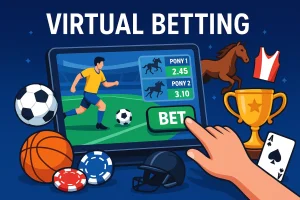Betist: Güvenilir ve Avantajlı Bahis Sitesi
Betist, Türkiye’de online bahis ve casino oyunları denildiğinde akla gelen en köklü platformlardan biridir. Yüksek oranlar, geniş oyun seçenekleri ve kullanıcı dostu arayüzü ile dikkat çeken Betist, güvenilir hizmetleriyle bahis severlere profesyonel bir deneyim sunmaktadır. Eğer Betist’e giriş yapmak veya güncel giriş adresini öğrenmek istiyorsanız, bu rehberde tüm detayları bulabilirsiniz.

📌 Betist Nedir?
Betist, bahis sektöründe uzun yıllardır faaliyet gösteren ve kullanıcılarına kaliteli hizmet sunan bir platformdur. Futbol, basketbol, tenis gibi spor bahisleri dışında sanal bahisler, canlı casino ve slot oyunları gibi çeşitli içeriklere de sahiptir. Kullanıcılarına yüksek oranlar ve çeşitli bonus fırsatları sunarak en iyi bahis deneyimini sağlamayı amaçlar.
🏆 Betist’in Avantajları
Betist’in kullanıcılarına sunduğu birçok avantaj bulunmaktadır:
- 🔒 Güvenilir ve Lisanslı: Betist, uluslararası bahis lisansına sahip bir platformdur ve güvenilirliği ile öne çıkmaktadır.
- 🎁 Cazip Bonuslar: Yeni üyelere özel hoş geldin bonusları ve sürekli güncellenen promosyonlar sunar.
- 💳 Hızlı Para Yatırma ve Çekme: Kullanıcıların hesaplarına kolayca para yatırmasını ve kazançlarını hızlı bir şekilde çekmelerini sağlar.
- 📱 Mobil Uyumlu: Betist, mobil uyumlu tasarımı ile her yerden erişilebilir.
- 🎮 Geniş Oyun Yelpazesi: Canlı bahis, casino, poker, slot oyunları ve daha birçok seçenek sunar.
🔗 Betist Giriş ve Güncel Adres
Betist’in resmi web sitesi, Türkiye’deki yasal düzenlemeler nedeniyle zaman zaman erişim engeline takılabilir. Bu yüzden kullanıcıların Betist güncel giriş adresini takip etmeleri önemlidir. Betist giriş yapabilmek için aşağıdaki adımları takip edebilirsiniz:
- Güncel adresi öğrenin: Betist’in sosyal medya hesaplarını ve bahis forumlarını takip ederek güncel adresi bulabilirsiniz.
- VPN Kullanımı: Eğer siteye erişim sağlanamıyorsa VPN kullanarak bağlanabilirsiniz.
- Mobil ve Masaüstü Erişim: Betist, hem mobil hem de masaüstü cihazlardan giriş yapabileceğiniz responsive bir tasarıma sahiptir.
📌 Betist Üyelik İşlemleri
Betist’e üye olmak oldukça basittir. İşte adım adım kayıt süreci:
- Betist güncel giriş adresine tıklayın.
- Ana sayfada bulunan “Kayıt Ol” butonuna tıklayın.
- Gerekli bilgileri (Ad, soyad, e-posta, telefon numarası) doldurun.
- Kullanıcı adı ve şifre belirleyerek hesabınızı oluşturun.
- E-posta veya SMS ile gelen aktivasyon linkine tıklayarak üyeliğinizi tamamlayın.
🎁 Betist Bonusları ve Promosyonları
Betist, kullanıcılarına birbirinden avantajlı bonus seçenekleri sunmaktadır. İşte en popüler bonus türleri:
- 🎉 Hoş Geldin Bonusu: Yeni üyelere özel olarak sunulan yüksek oranlı ilk yatırım bonusu.
- 💸 Kayıp Bonusu: Casino veya bahis kayıplarınızın belirli bir yüzdesini geri almanızı sağlar.
- ⚡ Yatırım Bonusları: Farklı yatırım yöntemlerine özel ek bonuslar.
- 🔄 Free Spin ve Bedava Bahis: Slot oyunları ve canlı bahisler için ücretsiz fırsatlar.
🎰 Betist Oyun Çeşitliliği
Betist, oyun severlere geniş bir yelpazede seçenek sunarak eğlenceli ve kazançlı bir deneyim vadeder. İşte platformda bulunan başlıca oyun kategorileri:
- ⚽ Spor Bahisleri: Futbol, basketbol, tenis, voleybol ve daha birçok spor dalında yüksek oranlarla bahis yapabilirsiniz.
- 🎲 Canlı Bahis: Maç esnasında bahis yaparak anlık değişen oranlardan faydalanabilirsiniz.
- 🎰 Slot Oyunları: En popüler slot oyunları, jackpot slotlar ve video slotlar ile keyifli vakit geçirebilirsiniz.
- 🃏 Canlı Casino: Gerçek krupiyelerle rulet, blackjack, baccarat ve poker oynayabilirsiniz.
- 🀄 Sanal Bahisler: Futbol, at yarışı, motor yarışı gibi sanal spor etkinliklerine bahis yapabilirsiniz.
- 🎮 E-Spor Bahisleri: CS:GO, League of Legends, Dota 2 gibi popüler e-spor turnuvalarına bahis yapabilirsiniz.
- 🎱 Tombala ve Okey: Eğlenceli ve kazançlı tombala, okey oyunları ile farklı bir deneyim yaşayabilirsiniz.
💰 Betist Para Yatırma ve Çekme Seçenekleri
Betist, kullanıcılarına güvenli ve hızlı para yatırma/çekme yöntemleri sunar. İşte en çok tercih edilen yöntemler:
- Banka Havalesi/EFT
- Papara
- Cepbank
- Bitcoin ve Kripto Paralar
- QR Kod ile Ödeme
- Kredi Kartı ve Sanal Kartlar
📱 Betist Mobil Kullanımı
Betist, mobil cihazlardan da sorunsuz bir şekilde erişim imkanı sunmaktadır. Kullanıcılar mobil tarayıcılar üzerinden siteye giriş yapabilir ya da Betist mobil uygulamasını indirerek daha hızlı ve pratik bir bahis deneyimi yaşayabilir.
🛡️ Betist Güvenilir mi?
Betist, kullanıcı bilgilerini koruyan gelişmiş güvenlik sistemleri ile donatılmıştır. Ayrıca, lisanslı bir platform olması sebebiyle haksız kazanç, ödeme yapmama gibi sorunlarla karşılaşmazsınız.
📞 Betist Müşteri Hizmetleri
Betist’in kullanıcı dostu müşteri hizmetleri, 7/24 canlı destek ile sorularınıza anında yanıt vermektedir. E-posta, canlı chat veya WhatsApp hattı üzerinden destek alabilirsiniz.
✨ Sonuç
Betist, sunduğu yüksek oranlar, geniş oyun seçenekleri, hızlı ödemeler ve güvenilir altyapısı ile bahis severler için en iyi alternatiflerden biridir. Betist giriş yaparak siz de bu avantajlı dünyaya adım atabilirsiniz. Güncel giriş adresini takip ederek kesintisiz bahis keyfini yaşayabilirsiniz! 🎰🎉
